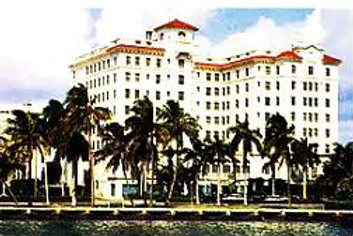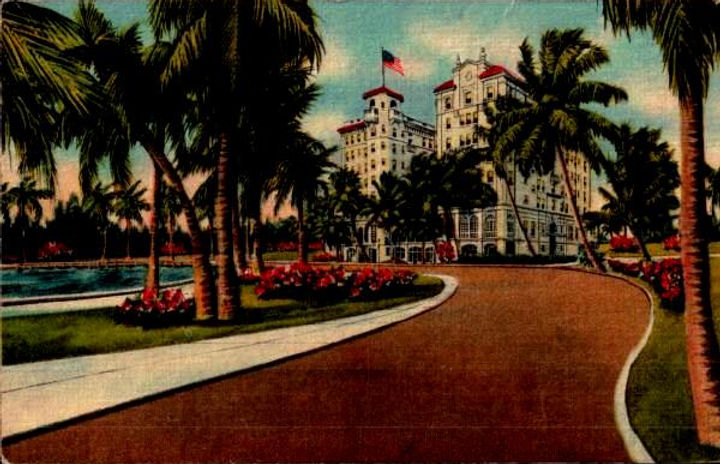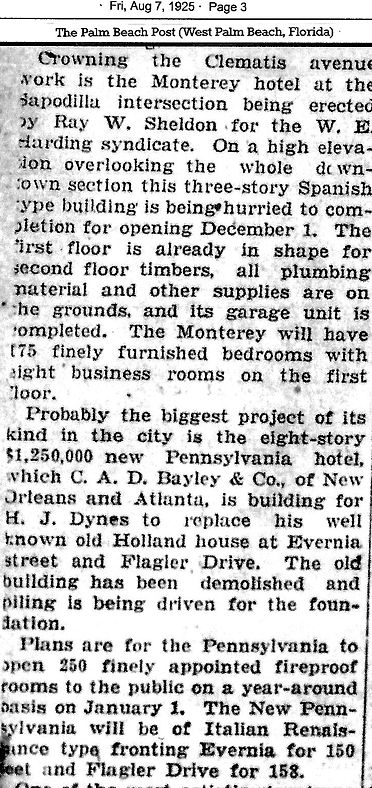PBSCV1599

Gen. James Patton Anderson Camp 1599
Celebrating 34 Years 1992 - 2026





The Pennsylvania: The last of the West Palm Beach grand hotels
April 30, 1994 Archives.
By AVA VAN de WATER
Palm Beach Post Home Editor
In the booming 1920s, downtown West Palm Beach had dozens of hotels and rooming houses that drew tourists for the winter social season. The Intracoastal Waterway lapped at the hotel door fronts, and ferries shuttled guests to and from Palm Beach.
Today, just one of those grande dames remains, and maybe not for long. The Pennsylvania Hotel sits quietly on South Flagler Drive, only its elegant ivory facade, arched windows and graceful lines hinting of its social heyday.
“The Pennsylvania was the biggest, the fanciest and the nicest,” said Dale Waters, historic planner for West Palm Beach.
Built in 1926 – smack in the middle of prohibition – the hotel was dubbed “The Breakers West.” It was the site of balls, coming out parties, elegant dinners, and other celebrations associated with the city’s social season. Even slot machines graced its halls.
Now, the eight-story, 230-room building has a more serene role – a residence for the elderly run by the Carmelite Sisters for the Aged and Infirmed of South Florida Inc. But the hotel is abuzz again since the Sisters announced plans to raze the former hotel to make way for a 19-story, up-to-date residence for the independent elderly as well as those needing special care.
Preservationists are upset about the possibility of losing the hotel, one of the last large Mediterranean Revival-style buildings downtown.
Designed by the prestigious firm of Harvey & Clarke as a prime example of the Mediterranean style so popular in the 1920s, the hotel has graceful arches, a tower and decorative ornamentation. A flat roof is hidden by parapets, decorated with barrel tile.
Inside, the crown jewel is a beautifully tiled mezzanine, where 4-inch squares of Spanish tile provide a gleaming backdrop for high ceilings. Wonderful columns are decorated up to 4 feet with colorful blue, green and yellow tiles made by Addison Mizner’s factory.
The Pennsylvania once hummed with activity. The dining room seated 400; a beauty shop and barber shop had a steady stream of customers. But today, footsteps echo in the halls of the nearly empty building that is being prepared for an uncertain future.
Of the half-dozen resort hotels that graced the downtown waterfront, only the Pennsylvania remains. The former George Washington Hotel, now the Helen Wilkes Residence Hotel, has been dramatically altered. Long gone are the Lake Court (now the site of the Noreen McKeen Residence next to the Pennsylvania), the Salt Air (the old downtown Holiday Inn site), the Royal Palm, the Monterey and the South Palm Inn.
Designed to be entered from Evernia Street, the hotel features a large, arched window with iron grill and stairs that lead to the grand mezzanine. Unfortunately a large canvas awning hides the window’s beauty, and an alternate entrance, favored by the Carmelite Sisters, takes visitors into a lobby of 1960s or ’70s vintage.
But beyond the mezzanine level, there is little of interest in the hotel.
The upper floors are marked by long, straight hallways that lead to small rooms with tiny baths. Although ceilings in the mostly 11-by-11-foot rooms are tall – about 12 feet – the hallways have dropped ceilings of acoustical tile that hide air-conditioning ducts and pipes. Contemporary bamboo wallpaper lines the walls; new carpet covers the concrete floors.
And while there is a beautiful crystal doorknob here, a simple brass knob there, the rooms are nondescript. New windows with plastic mullions replaced original double-hung sash windows in the mid-1980s. Tiny bathrooms with tall tubs hinder the elderly, and ill-designed fire exits lead not to the outside, but to the mezzanine or lobby.
“The facade of the building is beautiful. The mezzanine is beautiful. The functional use of the building ends right there,” said Kathleen Chobot, spokeswoman for the Carmelite sisters.
But preservationists hope to preserve the facade – and a part of West Palm Beach’s elegant past. They would like the sisters to consider gutting the interior of the building (except for the grand mezzanine level) rather than tearing it down.
“There is not a whole lot left downtown,” Waters said. Of 25 major buildings, “maybe 6 or 7 are of landmark status . . . There really isn’t another major building downtown in that style.”
THE PENNSYLVANIA THROUGH THE YEARS
1900: Henry M. Flagler sells the land at what is now the southwest corner of Evernia Street and Narcissus Avenue to Wilmon Whilldin. The same year, Whilldin sells it to Lewis D Lookwood.
1901: Lockwood erects a four-story, wood-frame hotel, the Holland House. To the east of the hotel sits a public park and boat pier.
1923: Lockwood sells Holland House to Henry J. Dynes.
1925: Dynes buys the lot next door, razes Holland House and commissions the architectural firm of Harvey & Clarke to design the eight-story Pennsylvania Hotel.
1926: The 216-room Pennsylvania Hotel opens.
1927: Financial troubles plague the hotel. Harvey & Clarke files a $6,000 lien against it.
1930: Florida-Collier Coast Hotels Inc. takes over the Pennsylvania, renaming it the Royal Worth Hotel.
1943: Robert Kloeppel of Jacksonville buys the Royal Worth, changing name back to the original
Pennsylvania Hotel. (Kloeppel also owns the George Washington Hotel – now known as the Helen Wilkes Residence Hotel and originally called the El Verano Hotel.)
1960: A two-story parking garage is added to the west of the hotel.
1961: A swimming pool is added on the east side, off the mezzanine and sun room. The pool deck forms the roof of a loggia on the ground level.
1964: Kloeppel’s heirs sell the Pennsylvania to the Carmelite Sisters for the Aged and Infirmed of South Florida Inc. for $800,000. By November, it is functioning as a seasonal and permanent private residence.
1965: The front desk area is converted to a chapel.
Mid-1980s: Extensive renovations are made to the hotel, including replacement of wood-frame sash windows with contemporary windows with plastic mullions.
1986: John Johnson of the Historic Palm Beach County Preservation Board approaches the sisters to nominate the hotel for the National Register of Historic Places. Administrator Sister Joseph agrees.
1987: A new administrator of the Pennsylvania Retirement Residence, Sister M. Fidelis, writes to George W. Percy, State Historic Preservation Officer, stating that the sisters “strongly object to the property’s inclusion on the National Register.” No reason was given for the objection.
1994: Sisters announce plans to demolish the Pennsylvania and replace it with an 18-story, 230-bed nursing home and adult living facility.
C.J. WALKER Staff Photographer
1. The elegant 1926 Pennsylvania Hotel in West Palm Beach was nicknamed The Breakers West. It was the setting for elaborate social events and had slot machines in its hallway.
2. Graceful arches, a tower and external ornamentation on the Mediterranean-style Pennsylvania are worth keeping, preservationists say.
3. The Pennsylvania (above) as seen in a 1929 postcard. Its mezzanine has columns decorated with colorful tiles (left).
Originally appeared in The Palm Beach Post, Saturday, April 30, 1994, on page 1D.
